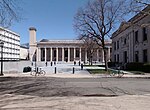Elizabethan Club

The Elizabethan Club is a social club at Yale University named for Queen Elizabeth I and her era. Its profile and members tend toward a literary disposition, and conversation is one of the Club's chief purposes. The Elizabethan Club's collection of 16th- and 17th-century books and artifacts include Shakespearean folios and quartos, first editions of Milton's Paradise Lost, Spenser's Faerie Queene, and Francis Bacon's Essayes, all locked in the club's vault. The collection is only available for inspection at certain times, or to researchers upon request at Yale's Beinecke Library. Tea is served daily during the semester and members may invite guests on specified days. The Club accepts female and male undergraduates, graduate students, faculty and staff.
Excerpt from the Wikipedia article Elizabethan Club (License: CC BY-SA 3.0, Authors, Images).Elizabethan Club
Elm Street, New Haven
Geographical coordinates (GPS) Address Nearby Places Show on map
Geographical coordinates (GPS)
| Latitude | Longitude |
|---|---|
| N 41.310388888889 ° | E -72.92625 ° |
Address
Elm Street Historic District
Elm Street
06511 New Haven
Connecticut, United States
Open on Google Maps





